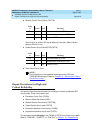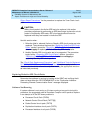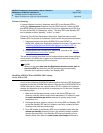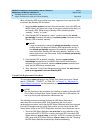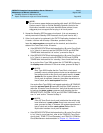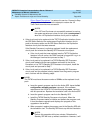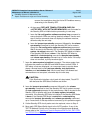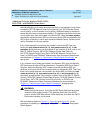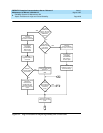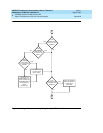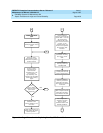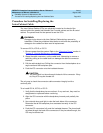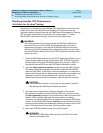
DEFINITY Enterprise Communications Server Release 6
Maintenance for R6vs/si
555-230-127
Issue 1
August 1997
Reliability Systems: A Maintenance Aid
Page 6-26Repair Procedures for High and Critical Reliability
6
!
WARNING:
Move only one SPE Select Switch at a time. DO NOT move both
switches at the same time.
!
WARNING:
If the Active SPE has alarms in it, an SPE-interchange may occur
after moving each SPE Select Switch back to the AUTO position.
Maintenance activity is performed automatically on the Standby SPE after the
SPE Select Switches are returned to their AUTO positions in Step 10. This can be
verified by issuing the status system command and noting that the Standby SPE
is labeled as “maint.” It may take up to 5 minutes for this activity to begin. The
maintenance activity itself takes from 10 to 30 minutes to complete.
NOTE:
The time required for the maintenance activity to finish depends on the
number of TN765 Processor Interface circuit packs, the number of
administered ports on the Processor Interface circuit packs, the number of
administered data channels on the TN777B Network Control circuit pack,
and the current load on the system.
Verify the completion of the maintenance activity by issuing the status system 1
command and noting whether the Standby SPE is labeled as “standby.”
Although not recommended at this stage of the procedure, the maintenance
activity on the Standby SPE can be preempted using the refresh spe-standby
command. To preempt the maintenance activity, continue issuing the refresh
spe-standby command followed by status system 1 command until the status
system form shows that the Standby SPE is labeled “standby.”
It may be necessary to issue the refresh spe-standby command multiple times
to preempt all Standby SPE maintenance activity. If the refresh spe-standby
command successfully completes five times without the Standby SPE becoming
labeled “standby” on the status system form, wait 20 minutes. Issue the refresh
spe-standby command once more.
If the status system 1 command continues to show SPE alarms, issue the
appropriate command(s) from the G3MT terminal to test these alarmed MOs.
After Step 10, if the Active SPE contains more severely defective circuit packs
than the Standby SPE, an SPE-interchange may occur. The presence of alarms in
the Active and Standby SPE can be verified by issuing the status system
command. The status system form indicates the presence of MAJOR and MINOR
alarms on both SPEs. If the Active SPE has alarms in it, an SPE-interchange may
occur. The occurrence of the SPE-interchange can be verified by issuing the
status system command to determine which SPE is now the Active SPE.



